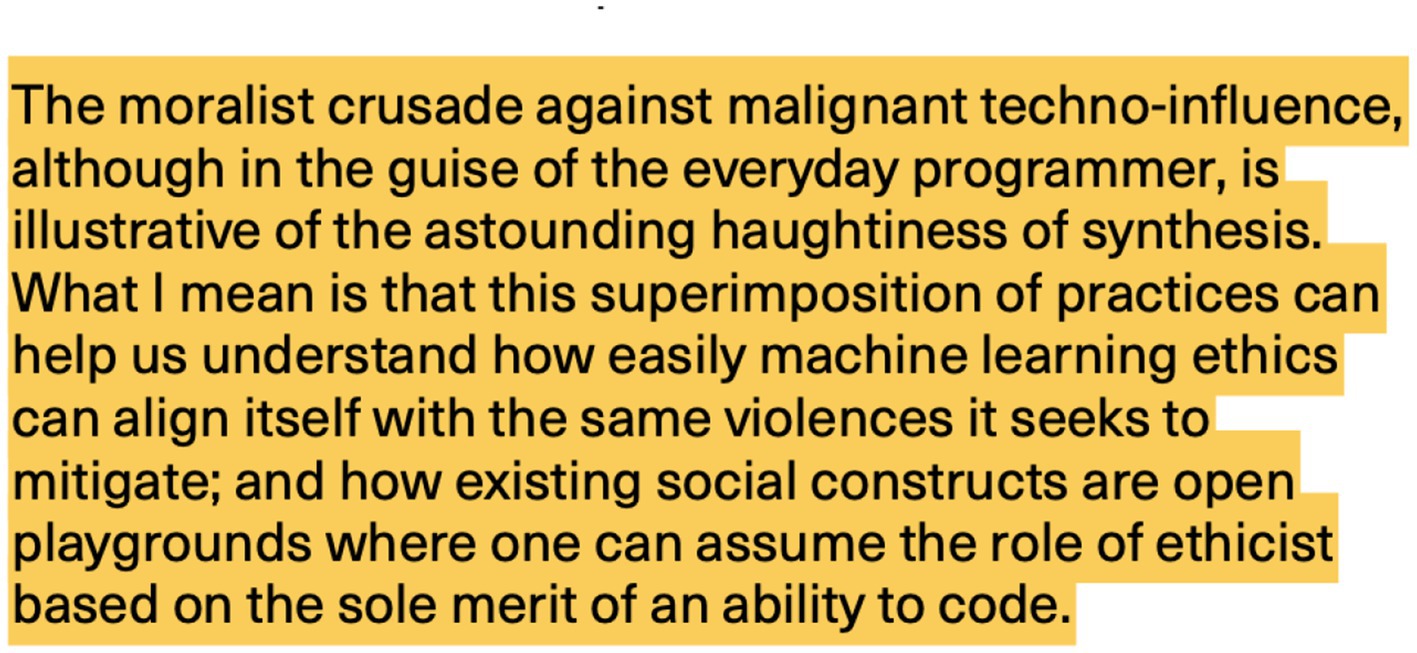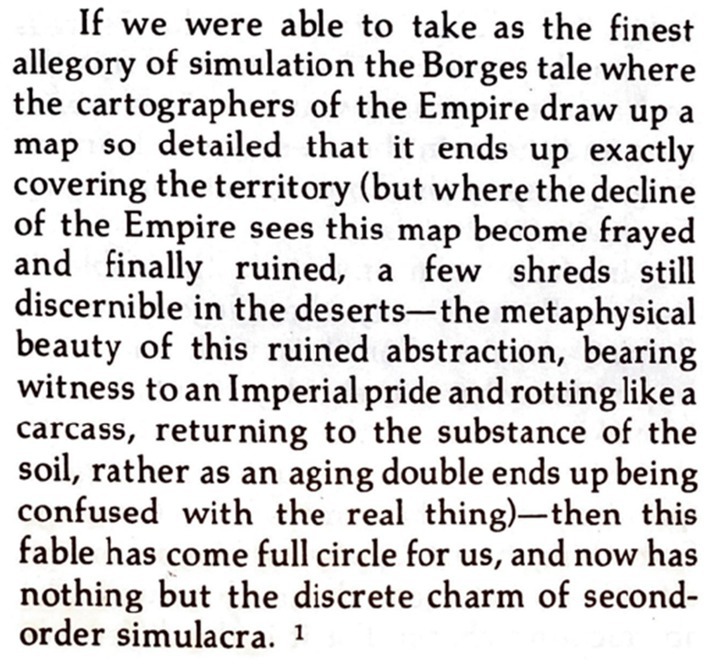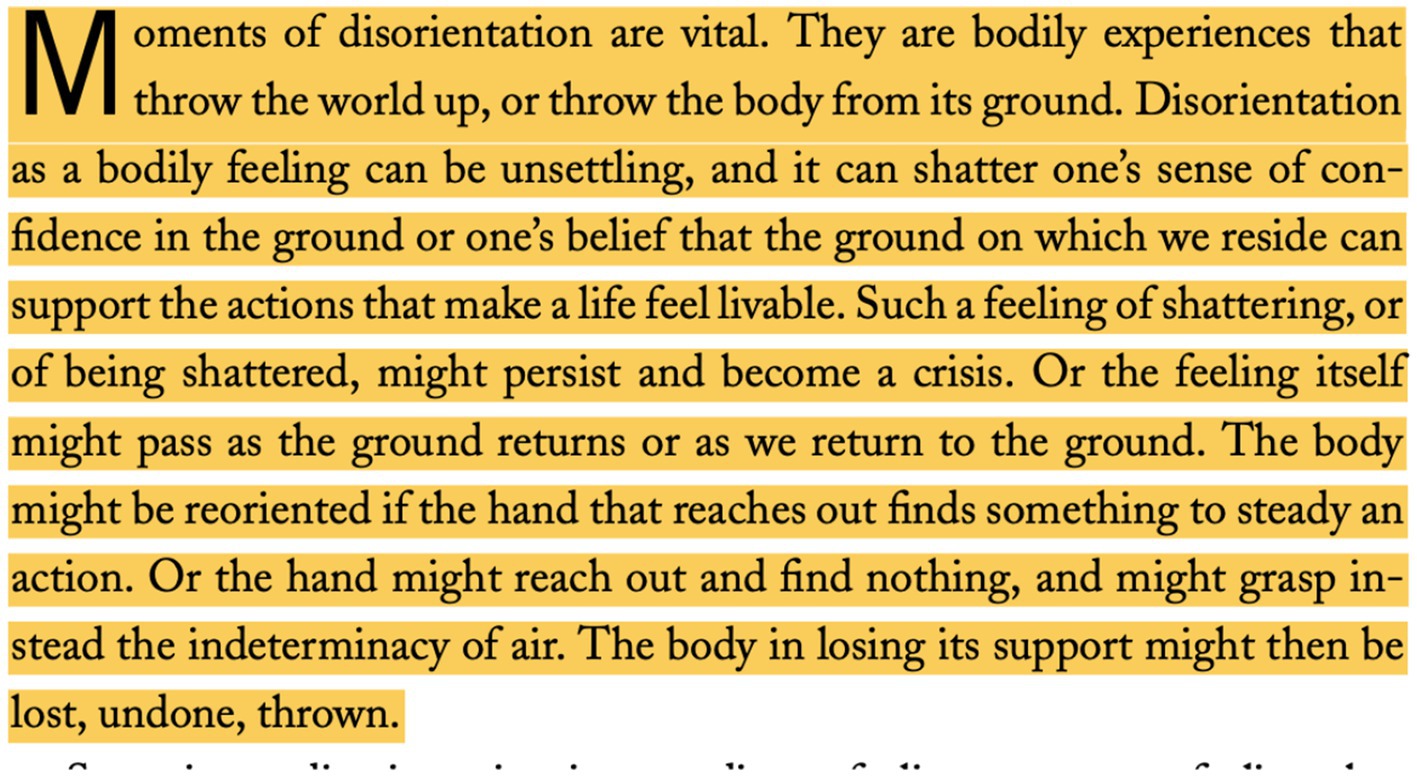- Art and Design Department in College of Arts Media and Design at Northeastern University, Boston, MA, United States
Speculative Black Feminist Epistemologies of Worldbuilding for XR is a methodology attempting to address space, the production of space, permission of space, the economy of space, and evading the confines of space by activating possible imaginaries in the development of XR (Extended Reality) environments. Through a praxis straddling academic and artist writing, the argument explores an experimental approach to Worldbuilding for XR by upending the role of Cartesian coordinates as the default measurement of 3D space. The possibilities afforded XR technologies allow for experimenting with unrestricted navigation of Black women’s cartographic movements, which is impossible in real-world geography. The core proposition of the Black Feminist Episteme of Worldbuilding is the praxis of de-mapping. This praxis foregrounds fugitive movements and spaces by utilizing XR Worldbuilding affordances as a speculative container for reimagining navigation for identities under conditions of subjugation. Researching and speculating about the affordances of XR is a critical intervention attempting to counter mainstream development and deployment of immersive media technology dedicated to the pedagogical tasks of gaming, militarization, and other real-world training applications. The first move toward the praxis of de-mapping, an arrival, is acknowledging the material composition and operation of XR technology. The second move and the first departure explore intentional disorientation. The third move interrupts the linearity of departures and arrivals to establish mobility as a counter-cartographic methodology by referencing the female protagonists in the study by Octavia E. Butler.
Introduction
Let us attempt to consider space (computational and terrestrial), the production of space, the permission of space, the economy of space, and evading the confines of space through the possible imaginaries of Black Feminist geographic ontologies for XR Worldbuilding. XR stands for Extended Reality, encompassing hardware and software for virtual reality, augmented reality, and mixed reality. These technologies are considered spatial computing, a broad term for human–computer interactions that happen in real-world space not necessarily mediated by a traditional screen. Black Feminist Epistemology for Worldbuilding aligns the Black Feminist perspective on geography with XR design in a speculative reimagining of the boundaries of digital space and reality.
This essay is experimental in execution, speculative in practice, and a meditation by methodology dedicated to explore Worldbuilding XR environment against their intended purposes and deployments. Black Feminist Worldbuilding is the practice of deconstructing terrestrial norms that support systemic subjugation (Figure 1). The destination is errant—not interested in a specific ending at predetermined coordinates. Instead, Black Feminist Epistemologies activate to reconfigure coordinates between contiguous arrivals and departures forging speculative inquiries into the canonical grammar of spatiotemporally.
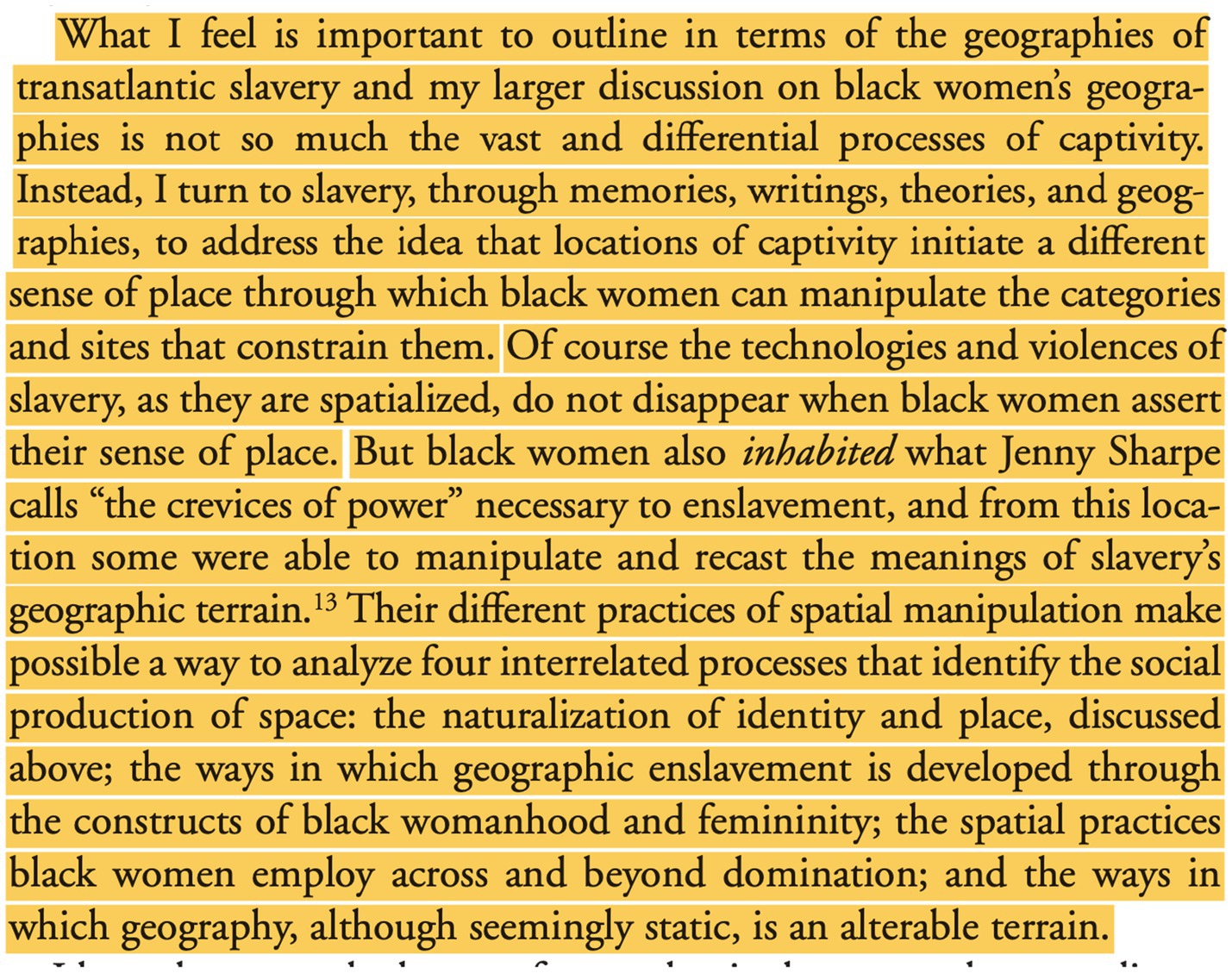
Figure 1. Katherine McKittrick, Demonic Grounds: Black Women and the Cartography of Struggle, pages 16–17.
Attempts at reconfiguring the mobility of Black women through counter-cartographies using spatial computing is called the praxis of de-mapping. The praxis of de-mapping foregrounds fugitive movements reimagining spatial configurations by utilizing XR Worldbuilding as a speculative container for disrupting the reliance on the linear conditions of space and time. The first move away from linear presumption is the arrival—acknowledging the material composition and operation of spatial computing. The second move and the first departure explore endeavors of intentional disorientation, not seeking the norm. The third move disrupts the linearity of departures and arrivals establishing mobility as a counter-cartographic methodology (Figure 1).
A ceremony for the hardware and software
Spatial computing is made possible by the materiality of hardware and software. Both elements are progeny relying on contemporaneous variants of the colonial project and extractivist capitalism. These tools are compulsory collaborators for exploring the generative and uncharted possibilities of XR technology. The material genealogy of industrialized technology begins with the extraction of the mineral Coltan (columbite-tantalite) in the Democratic Republic of the Congo by humans operating on the fragile edges of visibility and erasure. Kathryn Yusoff, in a lecture at the Harvard Graduate School of Design, cites that a “white utopia is a Black Inferno” because of extractive violence (Yusoff, 2020). Mainstream technology replicates social biases—automated algorithmic logistics of the colonial project. Ramon Amaro explicates in the essay Haunting, Blackness, and Algorithmic Thought (2021) that technology is not neutral and it is imbued with the ideologies of its creator, the coder (Figure 2).
The violence in technological bias is pervasive and at times inescapable—enacting as malignant deployments into society. The only option for combatting these inequities, erasures, and slippages is the act of repair through the praxis of decolonizing the technological landscape. To decolonize a technological design, its operation must be revised through recognition, refusal, infiltration, and accountability. In Dori (Elizabeth) Tunstall’s book Decolonizing Design a Cultural Justice Guidebook (2023), the chapter “Decolonizing Design Means Dismantling the Tech Bias in the European Modernist Project” traces Western technology advancement from the plantation to the contemporary. She writes about “better living” through solution-based technological evolution driven by capitalism and charted by “progress narratives” from the colonial project, which is the ultimate technology of capitalism, to consumer technologies unveiled during the 1893 Chicago’s World Fair. At the exposition celebrating the 400 years since Christopher Columbus “discovered the Dominican Republic” was the display of new technology AC electricity for indoor lighting, and consumer projects like Aunt Jemima Pancake mix. The contemporary discussion of “progress narratives” integrates the fantasy of Artificial intelligence (AI). The promotional material for the UAE (United Arab Emirates) World Expo 2022 touted AI as a life-changing innovation. The genealogy of technology and its logistical purpose are rooted in the extractive economies of capitalism. Tunstall speaks about the 1793 invention of the cotton Gin as a plantation technology for separating cotton, increasing the production of cotton requiring a surge in forced human labor and expansion in land theft to supply the demand (Tunstall, 2023). Researching XR technology and spatial computing attempts to revise relations of technology to society by reimagining the grammar of the default use. Using technology against its intended purpose to foreground counter-narratives and the abolishment of the coder’s bias is an act of Othering the hardware and software with care; this approach is critical for the praxis of de-mapping.
Unsettling geography by upending Cartesian coordinates, an arrival
Querying the possibilities of spatial computing and the establishment of space by the quintessential utilitarian nature of coordinates of cartography and territorialization requires recognition. Exploring the plurality possible to chart new cartographical narratives mediated by a Black Feminist lens troubles these spatial defaults. Reimagining the spatial computing landscape acknowledges the inherited violence of extractive and human labor-dependent economies showing reverence for their material composition.
The praxis of de-mapping as counter-cartography is available in XR technology where volume, coordinates, and orientation are alterable offering transferable properties in the terrestrial realm. As Jean Baudrillard explicates in his 1981 essay “The Precession of Simulacra,” the first paragraph references Borges’s allegory of the map as it relates to imperial territorialization (Figure 3). The map simulates the territory as if the scale was 1:1 showing material evidence of its relation to the physicality of terrain and potential porosity (Figure 3).
The praxis of de-mapping presents a speculative counter-cartography for repair. Maps trace the mountains mined, land stolen and overworked, and the oceans polluted. Counter-cartographies care for the terrorized landscape and the citizens of the margins, by observing fugitive productivity—a new set of relations is possible. Like the map in Borges’s allegory, let us push on where it is porous, let us fall through those fissures, those erosions of deterritorialization, mapping a new relationality of coordinates by upending the operation of three-dimensional space as fixed.
To consider the production of space and the movement of people, the default area of study is geography. Katherine McKittrick’s book Demonic Grounds: Black Women and the Cartographies of Struggle (2006) engages in an exercise of counter-cartography attempting to de-spatialize the Black ontological sense of forced displacement deployed during the terror of the colonial project. McKittrick is an ally in the praxis of de-mapping. By enacting the gesture of a spatial act in the form of resistance, the praxis of de-mapping speculates new forms of occupying and traversing space (McKittrick, 2006). Demonic Grounds (2006) revises the relationship of geography to colonial violence, imperialism, and domination by turning toward Black female geographies to construct counter-cartographies and fugitive imaginaries under forced occupation and inhospitable spaces of subjugation. The praxis of de-mapping ignites the alterable to evoke what McKittrick by way of Caribbean theorist Sylvia Wynter calls Demonic Grounds (Figure 4).
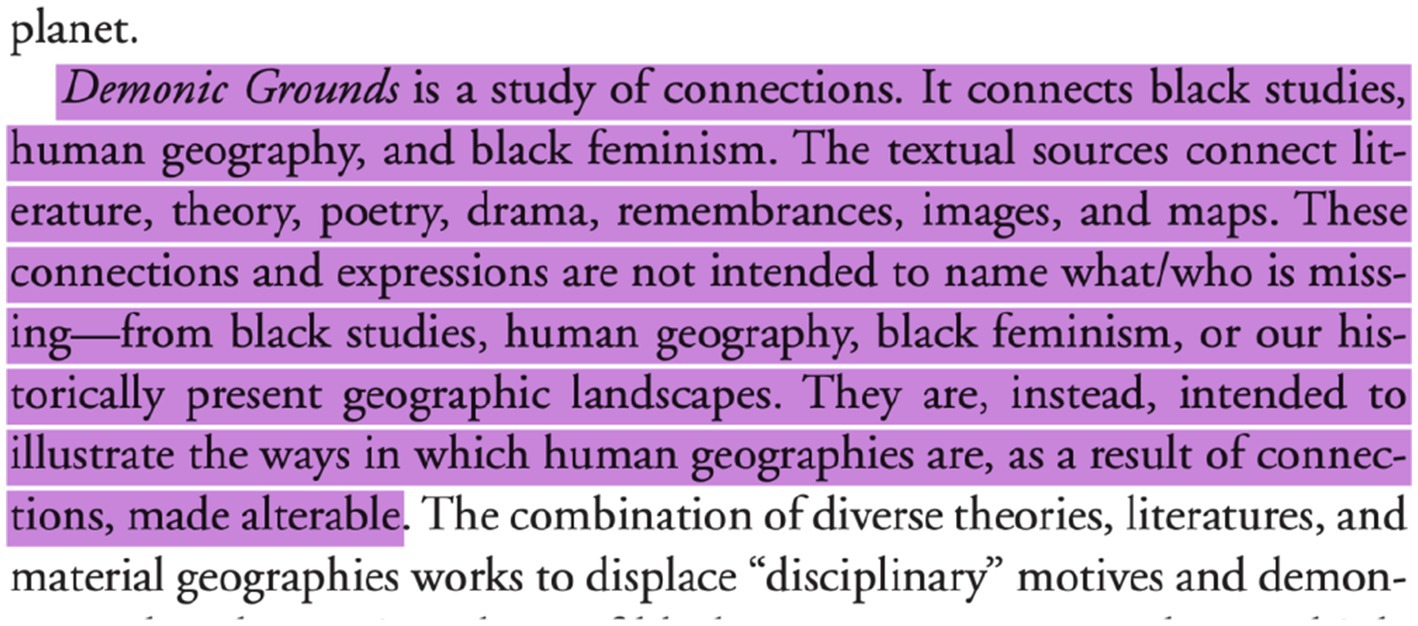
Figure 4. Katherine McKittrick, Demonic Grounds: Black Women and the Cartography of Struggle, page 31.
3D space is mapped, understood, and made navigable by utilizing Cartesian coordinates. Navigating terrestrial space shares the same reliance. Cartesian coordinates are a geometry system invented by mathematician, scientist, and metaphysician René Descartes (1596–1650) during the 17th century. Cartesian coordinates are foundational for the mapping of territories, journeys across land and sea, the location of natural resources, fortified people groups, and “new lands.” The One Cartesian coordinate system is the origin of the zero point, the X-axis. The second Cartesian coordinate system activates the Y-axis and implicates the X-axis; this enclosure fixes the location and makes the origin didactic. The X-axis and Y-axis coordinates make a location legible, and mappable—making way for the practice of cartography. The three Cartesian coordinate systems, the X-axis, the Y-axis, and the Z-axis, allow for cartography to encompass dimensional mobility. In the 3D computational spaces, the three-coordinate system is the default. The X- and Y-axis, this is how you know you are oriented right side up, the inclusion of the Z-axis allows for proximity and visibility. The production, legibility, and economy of space, digital and analog, depend on Cartesian coordinates. Let us return to Katherine McKittrick to discuss the navigation of space as three-dimensionality through a Black Feminist geographic lens.
If we think about the inexorable link between the three-dimensional cartography of the coordinates system and their attributions to imperialism and the colonial project as a maintenance tool for the categorical organizing of territories; McKittrick offers language for reconfiguring this spatial relationship (Figure 5). McKittrick paves the way for locating the liminal, the outsides, and the in-between relations of the three-dimensionality of the coordinates. These in-betweens are the Demonic Grounds —dislocating through the praxis of de-mapping (Figure 5).
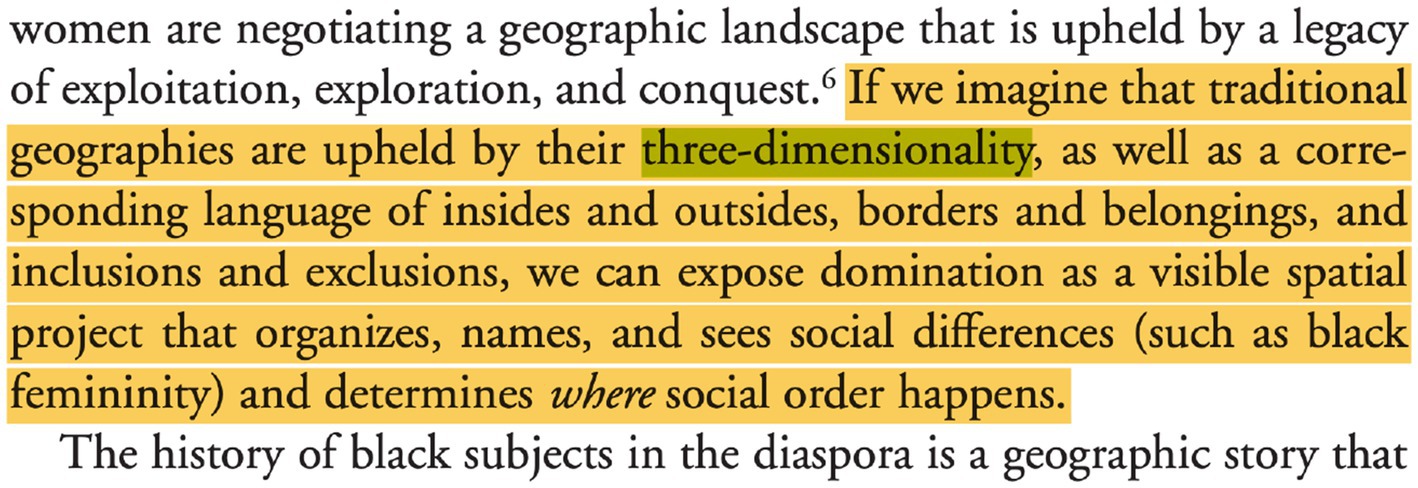
Figure 5. Katherine McKittrick, Demonic Grounds: Black Women and the Cartography of Struggle, page 14.
Disorientation as a departure
When entering 3D spatial development software, the intention is to be right side up and at the zero-origin point. The praxis of de-mapping is not seeking to be right side up at the zero point. Disrupting 3D space and the legibility of Cartesian coordinates is an operation of disorientation. In the book Queer Phenomenology Orientations, Objects, Others (2006), Sara Ahmed writes in “Conclusion: Disorientation and Queer Objects” how disorientation interrupts the sense of knowing the inertia of the bodily trajectory, and how letting go of the expectation can produce new orientations upending the bodies dependence on the ground and being right side up (Figure 6).
The praxis of de-mapping is the endeavor of undoing the fixed supports of the Cartesian coordinates by seeking disorientation, of being undone (Ahmed, 2006). Disorientation offers an entry point for embarking on counter-cartography, of being thrown and engaging the generative possibilities found from not being right side up. De-mapping as a counter-cartographic endeavor toward disorientation and the generative possibility of not being right side up offers a strategy for creating a new relation to coordinates, reimagining the grammar for occupying and moving through space grasping the indeterminacy of the air (Ahmed, 2006).
Unrestricted mobility as practiced through Transusbstantiality, Transversability, and Traversability
The praxis of de-mapping acknowledges the precarious conditions of fugitivity as it oozes out from these spaces into the real world. These spaces are the garret found in Harriet Jacobson’s autographical book Incidents in the Life of a Slave Girl (Jacobs, 2015), The Margins bell hooks discuss as being a radical womb of resistance (Hooks, 1989), and the mythopoetic making of the Drexciya narrative critically fabulated by electronic music duo of the same name. Drexciya charts the survival of babies born underwater when their pregnant enslaved mothers were thrown overboard slave ships by establishing a fugitive subaquatic society by adapting to their watery graves refusing erasure and thriving.
These instances of fugitivity offer parameters for moving toward Demonic Ground, of altering Black women’s relation to computation. Making a speculative offering for disrupting 3D Worldbuilding through the praxis of de-mapping, Denise Ferreira da Silva’s essay Toward a Black Feminist Poethics: The Quest(ion) of Blackness Toward the End of the World (2015) provides a substrate of porosity to return to the Borges allegory of the map (Baudrillard, 1983). Ferreira da Silva transcends the possibilities of Blackness as liberated from historical, biological, political, social, and systemic subjugation of the Western production of space and time. In the last portion of the essay “After the End? Virtuality, Transusbstantiality, Transversability, and Traversability,” Ferreira da Silva thinks about virtuality through the lens of Black Feminist Poethics as an indeterminate matter of Black ontology imagined and contingent. Her inquiry challenges spatial temporality by unpacking the act of navigating between virtuality, the liminal, and reality foregrounded by the female protagonists from prolific African American Science-Fiction Writer Octavia Estelle Butler’s novels (Da Silva, 2015).
Traversability—Dana Franklin from Kindred (1979) can time travel. Her ability to live in and between two temporalities is emblematic of Traversability—troubling the linear relations of spatial temporality Western society is dependent on. Butler tells the story of cross-generational time travel. Dana who is a writer living in 1979 Los Angeles with her Caucasian husband Kevin first experiences episodes of time travel triggered on her 26th birthday. Dana is transported back to her ancestor’s plantation in 19th-century antebellum Maryland (Butler, 2003). For Dana, traveling between the 20th and the 19th centuries is pedagogical to understanding the complexities of survival for Black women through time. Dana’s time travel episodes are perceived as uncontrollable, but through praxis, she learns how to bring herself back to the present. Dana’s relationship to her coordinates is of disorientation. She challenges the validity of coordinates regarding the linearity of spatial temporality by time traveling through the portal of her ancestorial genealogy. Her ability to move through time and space disrupting matter is the praxis of de-mapping by surviving the navigation of Traversability, the act of reordering the relationship to Cartesian coordinates in refusal of the linearity of space and time (Da Silva, 2015).
Transubstantiality—The book Wild Seed (1980) tells the story of two ancient immortal Africans, Doro and Anyanwu. Doro is a spirit that can occupy other bodies by killing his host identity upon jumping into them. Doro, fascinated by Anyanwu and her powers takes her to one of his breeding villages where he experiments with creating superhumans. Anyanwu can shapeshift into animals and humans, altering her volume and material appearance. She is also able to transfer energy for healing (Butler, 2020). Anyanwu’s powers allow her material volume to be altered in a tactic Ferreira da Silva describes as Transubstantiality. Transubstantiality is the transgression of categorical rendering of material, the will to be in flux, collapsing or expanding her volume, and transferring energy. She challenges her ontological coordinates to be illegible, to be fugitive. Transubstantiality is a praxis of de-mapping by producing the possibility of expanding, collapsing, and reorienting material coordinates to embody plurality, defying defaults of materiality (Da Silva, 2015).
Transversability—Lauren Olamina from The Parable of the Sower (1993) is a teenager who transitions to a young woman while occupying a post-apocalyptic anthropogenic, politicized, and racialized landscape of America. Lauren experiences a forced migration from her home and family, which is complicated by the fact that she is a Hyperempath (Butler and Jemisin, 2019). She can feel the pain and pleasure of those around her. Ferreira da Silva discusses her abilities as Transversability; her ability to collapse, and layer coordinates and the somatic markers of other bodies with that of her own. Transversability is the praxis of de-mapping through the ability to consolidate proximity coordinates between herself and others (Da Silva, 2015).
The inquiry into Butler’s work attempts to explore virtuality as a disruption of matter and orientation. This disruption of matter is a critical aspect of the praxis of de-mapping allowing for unrestricted mobility. Unrestricted mobility is crucial to the praxis of de-mapping made possible in the productive experimental nature of XR Worldbuilding—a computational space where coordinates could be altered and manipulated, returning to McKittrick on “manipulation and re-casting of terrain.” If the terrain is mainstream spatial computing for the development of navigable immersive media and the default applications, how can the terrain facilitate the praxis of de-mapping emerges as an inquiry? How can new terrain be constituted to support unconfigurable and unrestricted mobility of virtuality, the liminal space, the indeterminate in-between of being Transversal, Traversable, and Transubstantial?
A new terrain that is not fixed and determined is necessary for continuing to explore unrestricted mobility. Re-casting terrain creates a fugitive landscape, in the same operations of the garrets and the margins. To establish the re-casting of terrain, the activation of the shoal as outlined by Tiffany Lethabo King in The Black Shoals: Offshore Formations of Black and Native Studies (2019), the fugitive landmass enacts the grammar of a new terrain. The shoal, an emerging and submerging landmass, is a metaphoric interlocutor for the relations between Black and Native ontologies as both people groups live in a post-colonial landscape with the weight of coloniality in their quotidian lives. Shoals are offshore formations that can exist in various materialities from the granular nature of sand to the fortified nature of limestone or as a discrete ecology of coral (King, 2019). When not legible and announced, a shoal can cause disruption and disorientation to boats, ships, and other aquatic technologies relying on Cartesian coordinates. In the praxis of de-mapping, the shoal is erected to be an interlocutor between geography, and spatial computing enabling the counter-cartographic spatial act. In the praxis of de-mapping the shoal becomes a non-locatable site of possibilities for collapsing, expanding, and reordering coordinates. The shoal can shift its relation to legibility, volume, and proximity. Unrestricted mobility is activated and made possible by the shoal.
Conclusion—disorientated coordinates
The concluding inquiry at this moment, this fragile vertical slice of temporality, is the question of how the praxis of de-mapping facilitated by spatial computing disrupts, disorients, and reorganizes the relationality to Cartesian coordinates steps outside of the confines of the hardware and the software to exist in IRL (in real life). In 3D environment development, the materials, interfaces, and literacy make it possible to create XR experiences where indeterminate relationships between objects, avatars, ground planes, and the environment can be explored. Disorientation, as unpacked through Queer Phenomenology (2006), provides a departure for navigating against the default of being right side up. Mobility in interactive 3D spaces can be unrestricted and is critical to exploring the praxis of de-mapping through the method of virtuality as illustrated through enacting the qualities of Transusbstantiality, Transversability, and Traversability (Da Silva, 2015). The shoal as an uncharted, unmappable, and non-locatable landmass defined by arrivals and departures of legibility provides the context for de-mapping through unrestricted mobility. The shoal (King, 2019) is always in formation, always available, and has a plurality of proximities. Spatial computing offers the opportunity for unpredictability and indeterminates of spatial configuration. Experimenting with the unmappable virtually, erecting a shoal to support mobility in the software and hardware, brings forth the question of can those coordinates overwrite onto the terrestrial landscape. XR technology can be portals where the praxis of de-mapping can step out of the binary confines of the digital into the physical fleshly tangibility of the material world. The praxis of de-mapping in 3D spaces returns us to the Borges allegory (Baudrillard, 1983) of deterritorialization through experimental simulations.
Data availability statement
The original contributions presented in the study are included in the article/supplementary material, further inquiries can be directed to the corresponding author.
Author contributions
CH: Writing – original draft, Writing – review & editing.
Funding
The author(s) declare that no financial support was received for the research, authorship, and/or publication of this article.
Conflict of interest
The author declares that the research was conducted in the absence of any commercial or financial relationships that could be construed as a potential conflict of interest.
Publisher’s note
All claims expressed in this article are solely those of the authors and do not necessarily represent those of their affiliated organizations, or those of the publisher, the editors and the reviewers. Any product that may be evaluated in this article, or claim that may be made by its manufacturer, is not guaranteed or endorsed by the publisher.
References
Ahmed, S. (2006). “Conclusion disorientation and queer objects” in Queer phenomenology orientations, objects, others (Durham, NC: Duke University Press), 157.
Baudrillard, J. (1983). “The precession of simulacra” in Simulations. eds. P. Patton, P. Foss, and P. Beitchman (New York, N.Y: Semiotext(e)), 1.
Butler, O. E., and Jemisin, N. K. (2019). Parable of the sower. New York, N.Y: Grand Central Publishing.
Da Silva, D. F. (2015). Toward a black feminist Poethics. Black Scholar 44, 81–97. doi: 10.1080/00064246.2014.11413690
Jacobs, H. A. (2015). Incidents in the life of a slave girl: An autobiographical account of an escaped slave and abolitionist. New York, NY, N.Y: Skyhorse Publishing.
King, T. L. (2019). “Introduction” in The black shoals: Offshore formations of black and native studies (Durham, NC: Duke University Press), 1–15.
McKittrick, K. (2006). “Introduction” in Demonic grounds: Black women and the cartographies of struggle (Minneapolis, MN: University of Minnesota Press), 1–31.
Tunstall, E. (2023). “Chapter 2 DECOLONIZING DESIGN MEANS dismantling the tech Bias in the European modernist project” in Decolonizing design: A cultural justice guidebook (Cambridge, MA: The MIT Press), 39–50.
Yusoff, K. (2020). “KAthryn Yusoff, ‘geo-logics: natural resources as Necropolitics.’” Harvard Graduate School of Design, Available at: https://www.gsd.harvard.edu/event/kathryn-yusoff-natural-resources-as-geologic-necropolitics/.
Keywords: XR development, Black feminism, geography, counter-cartography, immersive media, spatial computing, speculative narrative, Black Feminist Epistemologies
Citation: Hill C (2024) Speculative Black Feminist Epistemologies of Worldbuilding for XR. Front. Commun. 9:1371081. doi: 10.3389/fcomm.2024.1371081
Edited by:
Jeneen Naji, Maynooth University, IrelandReviewed by:
E. L. Putnam, Maynooth University, IrelandCopyright © 2024 Hill. This is an open-access article distributed under the terms of the Creative Commons Attribution License (CC BY). The use, distribution or reproduction in other forums is permitted, provided the original author(s) and the copyright owner(s) are credited and that the original publication in this journal is cited, in accordance with accepted academic practice. No use, distribution or reproduction is permitted which does not comply with these terms.
*Correspondence: Clareese Hill, Y2xhcmVlc2VoaWxsQGdtYWlsLmNvbQ==; Yy5oaWxsQE5vcnRoZWFzdGVybi5lZHU=
 Clareese Hill
Clareese Hill